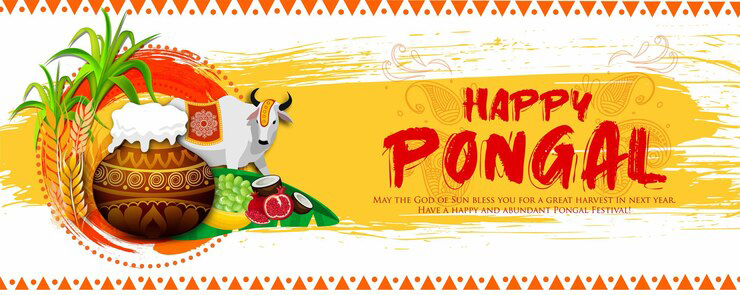Pongal finds its roots in ancient agricultural practices, where farmers expressed gratitude to the Sun God for a bountiful harvest. The festival’s name is derived from the Tamil word “Pongal,” which means “to boil over,” symbolizing the overflowing of prosperity and happiness. Over time, Pongal has evolved into a multi-day celebration, marked by feasts, traditional games, and vibrant attire that reflects the cultural diversity of India with colorful decorations, singing, dancing, fairs, flying kites. Each region brings its unique customs and rituals to the festivities, creating a tapestry of diverse celebrations that collectively capture the spirit of Pongal. The festival marks the end of the winter season and the first day of the Sun’s return journey to Northern Hemisphere, that is when Sun enters the Zodiac Makara (Capricorn). The Pongal festival is celebrated for 4 days; the Thai Pongal which is celebrated second day of the festival is the most auspicious day for Tamil Nadu people. While Pongal is deeply rooted in South Indian traditions, its celebration extends beyond regional boundaries. In different states, the festival is known by various names, such as Makar Sankranti in the north, Uttarayan in Gujarat, Hadaga in Maharashtra and Magh Bihu in Assam.
Now Let’s Read How Pongal Festival is Celebrated
Bhogi Pongal (Day1) – Cleaning and Discarding
Significance: This day is dedicated to cleaning and discarding old and unwanted items, symbolizing a new beginning.
Thai Pongal (Day2) – Main Harvest Festival
Significance: It is dedicated to expressing gratitude to the Sun God for a successful harvest.
Activities:
- Kolam, intricate rangoli-like patterns, are drawn at the entrance of homes.
- Early morning, households prepare a special dish known as ‘Pongal’ in new clay pots.
- The Pongal dish is made with newly harvested rice, jaggery, milk, and ghee, and it is allowed to boil over, symbolizing abundance.
- People wear new clothes and offer prayers to the Sun God, expressing gratitude for the harvest.
- Temples are adorned with decorations, and special prayers are conducted.
Mattu Pongal (Day3) – Celebrating Cattle
Significance: This day is dedicated to showing gratitude to cattle, which play a crucial role in agriculture.
Activities:
- Cattle, particularly cows and bulls, are bathed, adorned with colorful accessories, and worshipped.
- In some places, traditional bull-taming sports called ‘Jallikattu’ are organized.
Kaanum Pongal (Day4) – Family Day
- Significance: It is a day for family get-togethers and outings.
- Activities:
- Families visit relatives and friends.
- Outdoor activities, picnics, and excursions are common.
- Temples and public places witness festive gatherings.
- Traditional folk dances like Kolattam and Kummi are performed during Pongal.
Cultural Celebrations
Pongal, celebrated across India, marks the harvest season. In North India, Makar Sankranti involves kite flying and bonfires. Gujarat’s Uttarayan hosts an International Kite Festival. Assam’s Magh Bihu showcases Bihu dance. West Bengal’s Poush Parbon features traditional dishes. Punjab’s Lohri involves bonfires and sweets. Andhra Pradesh’s Bhogi Pandigai has bonfires and festive meals. Himachal Pradesh’s Khichdi celebrates with a special dish. Sri Lanka observes Thai Pongal with religious ceremonies.
“Hey there, let’s sprinkle some style on this Pongal celebration!”
South Indian Men’s and Women’s Wear
Saree – Vibrant silk Sarees like Kanchipuram Silk, Banarasi Silk and Pure Handloom Silk with intricate zari work are a traditional and elegant choice for South Indian festivals. Choose colors like red, green, or yellow for a festive look.
Pattu Pavadai Davani – Young girls often wear Pattu Pavadai Davani, a traditional South Indian outfit that consists of a silk skirt and blouse, adorned with gold or silver embellishments.
Temple Jewelry – Traditional gold or imitation temple jewelry, including necklaces, earrings, and bangles, complements South Indian festival attire and adorning the hair with a gajra (flower garland) adds a fragrant and traditional touch to the overall look.
Dhoti and Shirt – A veshti (dhoti) paired with a crisp shirt is a classic and comfortable choice for South Indian men during festivals.
Accessories – Add a touch of tradition with a silk angavastram and a simple necklace. Complete the look with traditional footwear like mojris or Kolhapuri chapels.
North Indian Men’s and Women’s Wear
Lehenga Choli – Embrace the elegance of North Indian culture with a colorful lehenga Choli. Choose contrasting colors and intricate embroidery for a festive look.
Accessories – Pair your outfit with a turban, a statement brooch, and traditional mojris. A watch or cufflinks can add a modern touch.
Kurta and Pajama – Embrace the regal look with a sherwani or keep it simple yet elegant with a kurta pajama in rich colors and Pair your outfit with a turban, a statement brooch, and traditional mojris. A watch or cufflinks can add a modern touch.
East Indian Men’s and Women’s Wear
Saree or Lehenga Saree – Women in East India often wear a unique style of sari or lehenga sari during Pongal. Look for silk or cotton fabrics with regional embroidery.
Accessories – Pair your outfit with statement earrings, a maang tikka, and bangles. A potli bag and mojris will add the perfect finishing touches.
Opt for loose curls or a braided hairstyle, adorned with fresh flowers or jeweled pins.
Dhoti and Kurta – Men in East India often opt for a dhoti and kurta or a sherwani during festive occasions. Choose pastel shades or vibrant colors. Add a silk stole or dupatta for an extra layer. Opt for traditional footwear like juttis or sandals.
West Indian Men’s and Women’s Wear
Anarkali Suit or Gharaga Choli – Embrace the festive spirit with an Anarkali suit or a ghagra choli in vibrant colors and traditional prints.
Accessories – Opt for statement jewelry like oversized earrings, a nose ring, and bangles. A clutch purse and Kolhapuri chappals can add a touch of authenticity and Choose loose waves, a fishtail braid, or a messy bun, complemented by traditional hair accessories.
Pathani Suit – Go for the traditional kurta and pajama or experiment with a Pathani suit in bold colors and intricate embroidery.
Enhance your look with a safa (turban), a statement brooch, and mojris. A wristwatch or bracelets can add a contemporary touch
Conclusion
As Pongal approaches, immerse you in the spirit of the harvest with Samyakk exquisite outfits. From vibrant silk Sarees to regal sherwanis, their collection beautifully blends tradition and modernity. Celebrate Pongal in style, whether you shop online at www.samyakk.com or visit their Bangalore store. Explore more festive collections that capture the essence of this joyous occasion. Samyakk not only offers fashionable ensembles but also a cultural experience, making your Pongal celebrations memorable and stylish. Embrace the festive vibes and indulge in the rich cultural tapestry of India with Samyakk, your go-to destination for Pongal attire. Happy Pongal!
FAQ
Q1: What are the key elements to consider when choosing a festive outfit?
A1: When selecting a festive outfit, consider the occasion, cultural significance, and personal style. Choose vibrant colors, intricate embellishments, and comfortable fabrics to ensure a perfect blend of tradition and modernity.
Q2: How do I accessorize my festive outfit for a complete look?
A2: Accessorize thoughtfully with statement jewelry, matching footwear, and a complementary clutch. Traditional accessories like maang tikka, jhumkas, and bangles enhance the festive vibe, completing your look with finesse.
Q3: Can I mix and match traditional and modern elements in my festive attire?
A3: Absolutely! Experiment by blending traditional silhouettes with contemporary styles. Pair a classic saree with a trendy blouse or combine a kurta with stylish bottoms. Mixing and matching allow you to express your unique style while respecting traditions.
Q4: What colors are considered auspicious for festive occasions?
A4: Colors like red, green, gold, and yellow are traditionally considered auspicious for festive occasions. However, feel free to experiment with a wide range of colors based on your personal preferences and the nature of the celebration.
Q5: Can I find festive outfits online, and how do I ensure the right fit when shopping online?
A5: Yes, Samyakk, offer festive outfits online. To ensure the right fit, carefully check the size chart provided by the retailer, which offer customization options for a perfect fit. As they offer a stunning collection blending tradition and style. With vibrant colors, intricate designs, and cultural authenticity, Samyakk ensures you celebrate in elegance.

